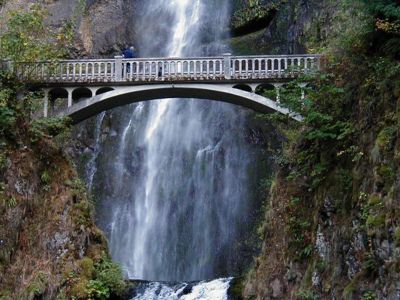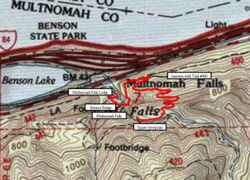Difference between revisions of "Multnomah Falls Hike"
From Oregon Hikers Field Guide
(Edits) |
(Add closure) |
||
| (10 intermediate revisions by 2 users not shown) | |||
| Line 4: | Line 4: | ||
[[Category:Waterfall Hikes]] | [[Category:Waterfall Hikes]] | ||
[[Category:Moderate Hikes]] | [[Category:Moderate Hikes]] | ||
| + | [[Category:Family Hikes]] | ||
[[Category:All Season Hikes]] | [[Category:All Season Hikes]] | ||
[[Category:Hikes]] | [[Category:Hikes]] | ||
[[Image:MultnomahFalls.jpg|thumb|400px|The Benson Bridge at Multnomah Falls is a recognized piece of Oregon history. ''(Steve Hart)'']] | [[Image:MultnomahFalls.jpg|thumb|400px|The Benson Bridge at Multnomah Falls is a recognized piece of Oregon history. ''(Steve Hart)'']] | ||
| − | [[Image: | + | [[Image:Little Multnomah Falls.jpg|thumb|250px|The top tier of Multnomah Falls ("Little Multnomah Falls") ''(bobcat)'']] |
[[Image:MultnomahPlatform.jpg|thumb|250px|Viewpoint at the top of the falls ''(Steve Hart)'']] | [[Image:MultnomahPlatform.jpg|thumb|250px|Viewpoint at the top of the falls ''(Steve Hart)'']] | ||
| + | [[Image:MultnomahFalls2.jpg|thumb|160px|Multnomah Falls ''(Steve Hart)'']] | ||
[[Image:MultFallsMap.JPG|thumb|250px|Approximate track of the trail]] | [[Image:MultFallsMap.JPG|thumb|250px|Approximate track of the trail]] | ||
| Line 25: | Line 27: | ||
=== Hike Description === | === Hike Description === | ||
| − | [[Multnomah Falls]], which includes three separate drops (the upper falls, the main falls, and the lower falls) for a total of 635 feet, is without doubt Oregon's most recognizable waterfall and arguably its most awe-inspiring. It is also the | + | <b><font color=red>NOTICE: Most trails on the Oregon side of the Columbia River Gorge are closed until further notice because of damage from the Eagle Creek Fire. The closure involves ALL trails between Rooster Rock State Park and Hood River. It is anticipated that most of these trails may not reopen until Spring or Summer 2018. Please check the list of [https://www.fs.usda.gov/recmain/crgnsa/recreation Columbia Gorge trail closures] before you plan for a hike.</font color></b> |
| + | |||
| + | [[Multnomah Falls]], which includes three separate drops (the upper falls, the main falls, and the lower falls) for a total of 635 feet, is without doubt Oregon's most recognizable waterfall and arguably its most awe-inspiring. It is also the tallest waterfall in Oregon. However, local boosters like to bill the waterfall as one of the highest waterfalls (second highest? fourth highest?) in the United States. Alas, according to the [https://www.worldwaterfalldatabase.com/country/United-States/tallest?page=1 World Waterfall Database], [[Multnomah Falls]] is the 156th tallest waterfall in the United States (That statistic includes some seasonal waterfalls). Nonetheless, the falls are an impressive sight, especially when they are a thundering plunge deep into the wet season or a muted ice-encased column in the throes of a freezing spell. The paved trail to the top of the falls involves threading through crowds of visitors from around the world: come before 9:00 a.m. if you want to experience a relatively people-free passage. At viewpoints along the way, you can experience different perspectives on the waterfall, which plunges from a hanging valley left high above the river bottom after the Columbia River carved its way through layers of basalt as the Cascade mountains began their period of uplift during the Pleistocene. | ||
The trail begins at [[Multnomah Falls Lodge]], a historic building built to serve early automobile travelers in 1925. From a photographer's viewpoint get a head on vista of both the lower and main tiers of [[Multnomah Falls]] and the picturesque span of the [[Benson Bridge]]. From here, the trail is a gently sloped 2/10 mile trail to the [[Benson Bridge]], built in 1914 by Simon Benson, one of the builders of the old highway. This part of the trail is a paved cakewalk, although one small flight of a few stairs blocks the way to wheelchairs beyond the lower falls viewpoint. | The trail begins at [[Multnomah Falls Lodge]], a historic building built to serve early automobile travelers in 1925. From a photographer's viewpoint get a head on vista of both the lower and main tiers of [[Multnomah Falls]] and the picturesque span of the [[Benson Bridge]]. From here, the trail is a gently sloped 2/10 mile trail to the [[Benson Bridge]], built in 1914 by Simon Benson, one of the builders of the old highway. This part of the trail is a paved cakewalk, although one small flight of a few stairs blocks the way to wheelchairs beyond the lower falls viewpoint. | ||
| Line 46: | Line 50: | ||
* U.S. Department of Agriculture, Forest Service: ''Zigzag Ranger District'' | * U.S. Department of Agriculture, Forest Service: ''Zigzag Ranger District'' | ||
* U.S. Department of Agriculture, Forest Service: ''Mt. Hood National Forest'' | * U.S. Department of Agriculture, Forest Service: ''Mt. Hood National Forest'' | ||
| + | * National Geographic Trails Illustrated Map: ''Columbia River Gorge National Scenic Area'' | ||
| + | * [https://www.dropbox.com/s/g921j250s93ky9p/MapHandout_2017.pdf Multnomah County SAR map] | ||
{{TripReports|Multnomah Falls}} | {{TripReports|Multnomah Falls}} | ||
| + | * [https://www.oregonhikers.org/forum/viewtopic.php?f=8&t=24971 Multnomah Falls, Jan 14th.] | ||
{{RelatedDiscussions|Multnomah Falls}} | {{RelatedDiscussions|Multnomah Falls}} | ||
| Line 54: | Line 61: | ||
* ''Day Hikes in the Columbia Gorge'' by Don J. Scarmuzzi | * ''Day Hikes in the Columbia Gorge'' by Don J. Scarmuzzi | ||
* ''Hiking the Columbia River Gorge'' by Russ Schneider, revised by Jim Yuskavitch | * ''Hiking the Columbia River Gorge'' by Russ Schneider, revised by Jim Yuskavitch | ||
| + | * ''70 Virtual Hikes of the Columbia River Gorge'' by Northwest Hiker | ||
* ''Best Hikes With Kids: Oregon'' by Bonnie Henderson | * ''Best Hikes With Kids: Oregon'' by Bonnie Henderson | ||
* ''Oregon: The Creaky Knees Guide'' by Seabury Blair, Jr. | * ''Oregon: The Creaky Knees Guide'' by Seabury Blair, Jr. | ||
Revision as of 15:44, 26 September 2017
- Start point: Multnomah Falls Trailhead
- End Point: Multnomah Falls Upper Viewpoint
- Trail log: Trail Log
- Distance: 2.4 miles round-trip
- High point: 895 feet
- Elevation gain: 870 feet
- Difficulty: Moderate Good trail, but quite a bit of climbing
- Seasons: Year-round
- Family Friendly: Yes
- Backpackable: No
- Crowded: Very
Contents |
Hike Description
NOTICE: Most trails on the Oregon side of the Columbia River Gorge are closed until further notice because of damage from the Eagle Creek Fire. The closure involves ALL trails between Rooster Rock State Park and Hood River. It is anticipated that most of these trails may not reopen until Spring or Summer 2018. Please check the list of Columbia Gorge trail closures before you plan for a hike.
Multnomah Falls, which includes three separate drops (the upper falls, the main falls, and the lower falls) for a total of 635 feet, is without doubt Oregon's most recognizable waterfall and arguably its most awe-inspiring. It is also the tallest waterfall in Oregon. However, local boosters like to bill the waterfall as one of the highest waterfalls (second highest? fourth highest?) in the United States. Alas, according to the World Waterfall Database, Multnomah Falls is the 156th tallest waterfall in the United States (That statistic includes some seasonal waterfalls). Nonetheless, the falls are an impressive sight, especially when they are a thundering plunge deep into the wet season or a muted ice-encased column in the throes of a freezing spell. The paved trail to the top of the falls involves threading through crowds of visitors from around the world: come before 9:00 a.m. if you want to experience a relatively people-free passage. At viewpoints along the way, you can experience different perspectives on the waterfall, which plunges from a hanging valley left high above the river bottom after the Columbia River carved its way through layers of basalt as the Cascade mountains began their period of uplift during the Pleistocene.
The trail begins at Multnomah Falls Lodge, a historic building built to serve early automobile travelers in 1925. From a photographer's viewpoint get a head on vista of both the lower and main tiers of Multnomah Falls and the picturesque span of the Benson Bridge. From here, the trail is a gently sloped 2/10 mile trail to the Benson Bridge, built in 1914 by Simon Benson, one of the builders of the old highway. This part of the trail is a paved cakewalk, although one small flight of a few stairs blocks the way to wheelchairs beyond the lower falls viewpoint.
Beyond the bridge, the asphalt trail switches up steeply for another mile to a ridgecrest (There are 11 switchbacks to be exact). At the first switchback, you'll come to the Larch Mountain-Gorge Trail Junction. At the third switchback, a scree slope shelters a busy colony of pikas, which tend to disappear when the midday crowds show up. As you ascend higher on the slope, look for Columbia River views. From the top, the trail drops slightly to a junction with a trail labeled "Top of the Falls Trail #441A" on some old Forest Service documents. Today's sign just says "Multnomah Falls Viewpoint". The asphalt follows a new side path to the Multnomah Falls Upper Viewpoint, a balcony of sorts at the lip of the falls looking down on the lodge and the less motivated people below. Most people take in this view, grab a couple of snapshots and return down the steep hill to that mocha latte thing.
Consider hiking further on the Larch Mountain Trail up Multnomah Creek to view Weisendanger Falls and Ecola Falls. Details are listed under the Larch Mountain Hike.
Fees, Regulations, etc.
- No fees
- Restrooms, restaurant, Forest Service information at Multnomah Falls Lodge
Maps
- Maps: Hike Finder
- Hiking Loops Near Multnomah Falls (USFS)
- Green Trails Maps: Bridal Veil, OR #428
- Green Trails Maps: Columbia River Gorge - West #428S
- Geo-Graphics: Trails of the Columbia Gorge
- U.S. Department of Agriculture, Forest Service/Bureau of Land Management: Columbia River Gorge
- U.S. Department of Agriculture, Forest Service: Zigzag Ranger District
- U.S. Department of Agriculture, Forest Service: Mt. Hood National Forest
- National Geographic Trails Illustrated Map: Columbia River Gorge National Scenic Area
- Multnomah County SAR map
Trip Reports
- Search Trip Reports for Multnomah Falls
Related Discussions / Q&A
- Search Trail Q&A for Multnomah Falls
Guidebooks that cover this hike
- Day Hikes in the Columbia Gorge by Don J. Scarmuzzi
- Hiking the Columbia River Gorge by Russ Schneider, revised by Jim Yuskavitch
- 70 Virtual Hikes of the Columbia River Gorge by Northwest Hiker
- Best Hikes With Kids: Oregon by Bonnie Henderson
- Oregon: The Creaky Knees Guide by Seabury Blair, Jr.
- Best Short Hikes in Northwest Oregon by Rhonda & George Ostertag
- The Columbia Gorge: Short Trips and Trails by Oral Bullard & Don Lowe
- Hiking Oregon's History by William L. Sullivan
- Waterfall Lover's Guide: Pacific Northwest by Gregory A. Plumb
- Waterfalls of the Pacific Northwest by David L. Anderson
- Hiking Oregon's Geology by Ellen Morris Bishop
- Fire, Faults, and Floods: A Road & Trail Guide Exploring the Origins of the Columbia River Basin by Marge & Ted Mueller
- Oregon Hiking by Sean Patrick Hill
- Pacific Northwest Hiking by Scott Leonard & Sean Patrick Hill
More Links
- Multnomah Falls Overlook Hike (Northwest Hiker)
- Oregon: Hiking Multnomah Falls (Steps to Wander)
- Multnomah Falls (Friends of the Columbia Gorge)
- Multnomah Falls (Oregon.com)
- Multnomah Falls Lodge
- Multnomah Falls (USFS)
- Multnomah Falls Recreation Area (USFS)
- Multnomah Falls (Northwest Waterfall Survey)
- Multnomah Falls (Oregon.com)
- Multnomah Falls (Travel Oregon)
- Multnomah Falls (Wikipedia)
- A Legend of Multnomah Falls (First People)
- 'Falling Rock Hurts 20" (New York Times)
- "Sorry, Multnomah Falls is not the second tallest waterfall in the U.S. (it's not even close)" (Oregon Live)
Contributors
- Stevefromdodge (creator)





